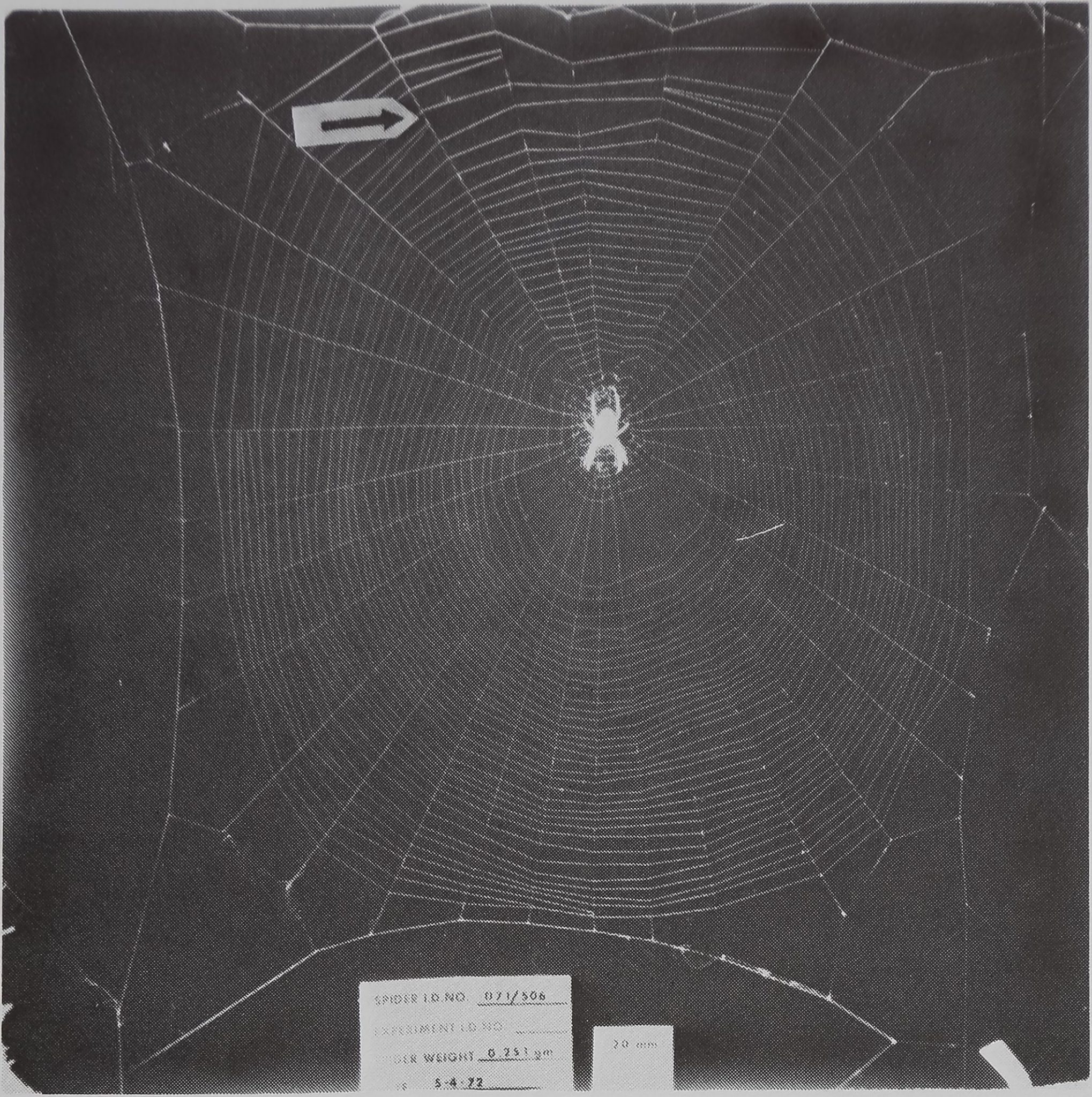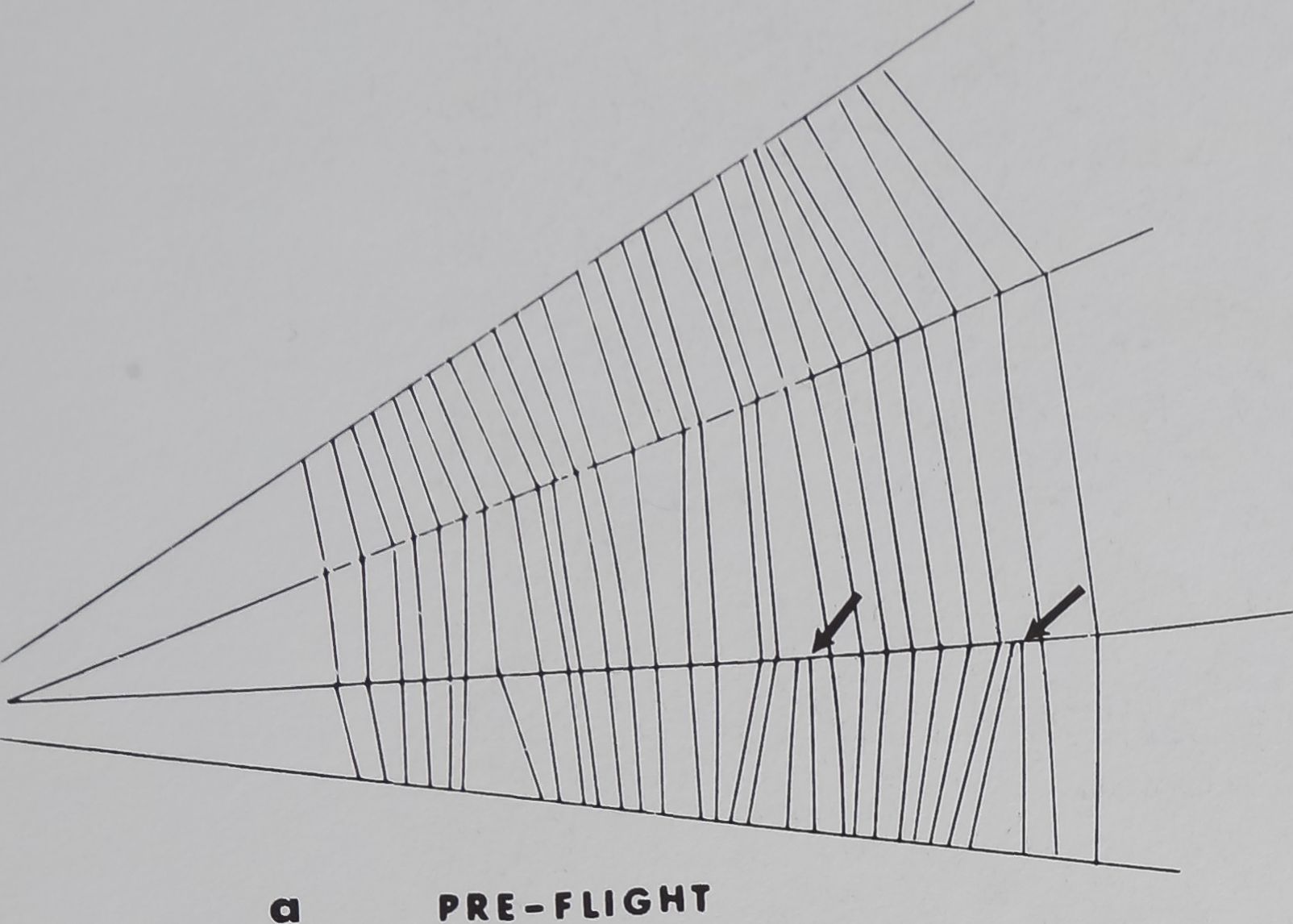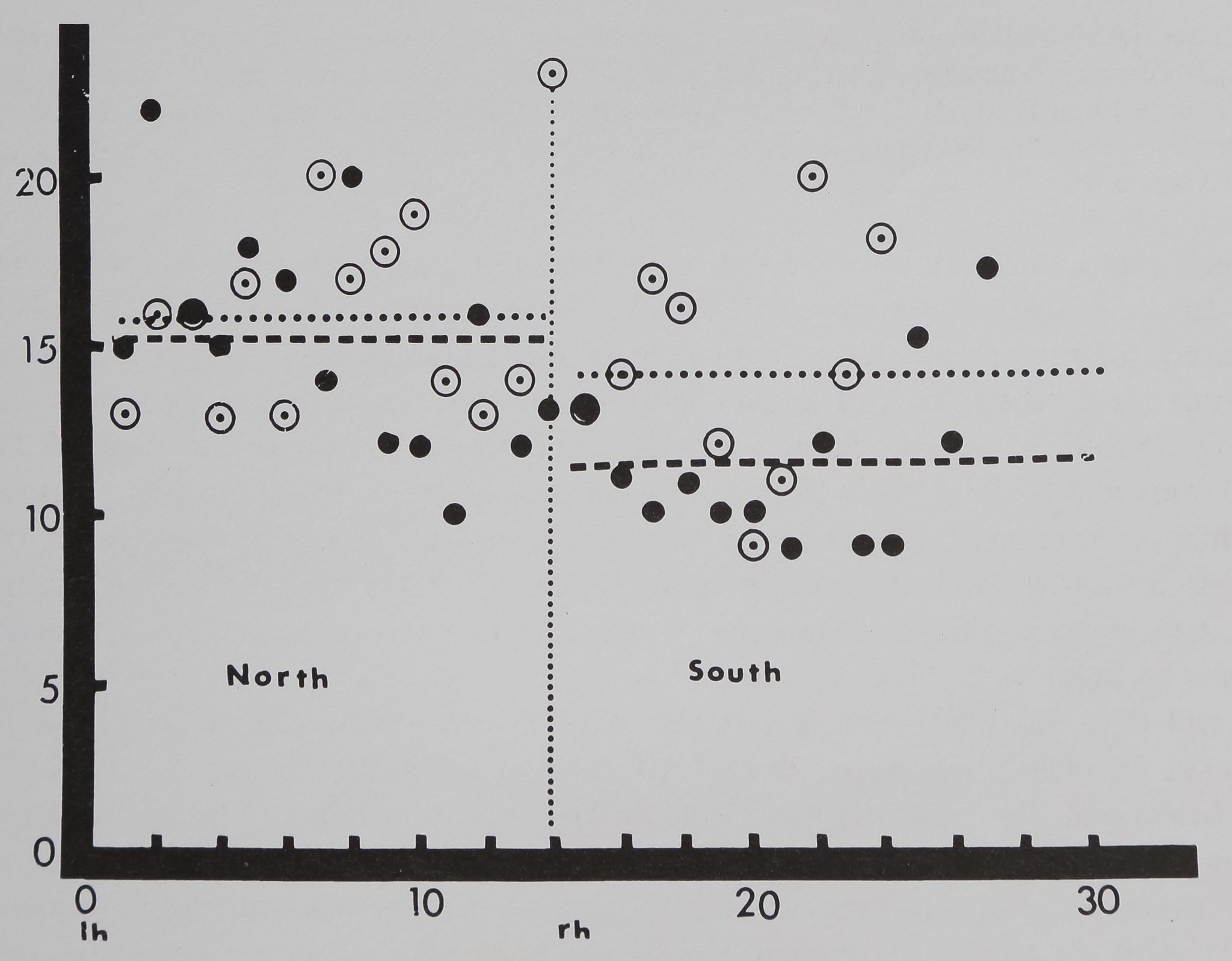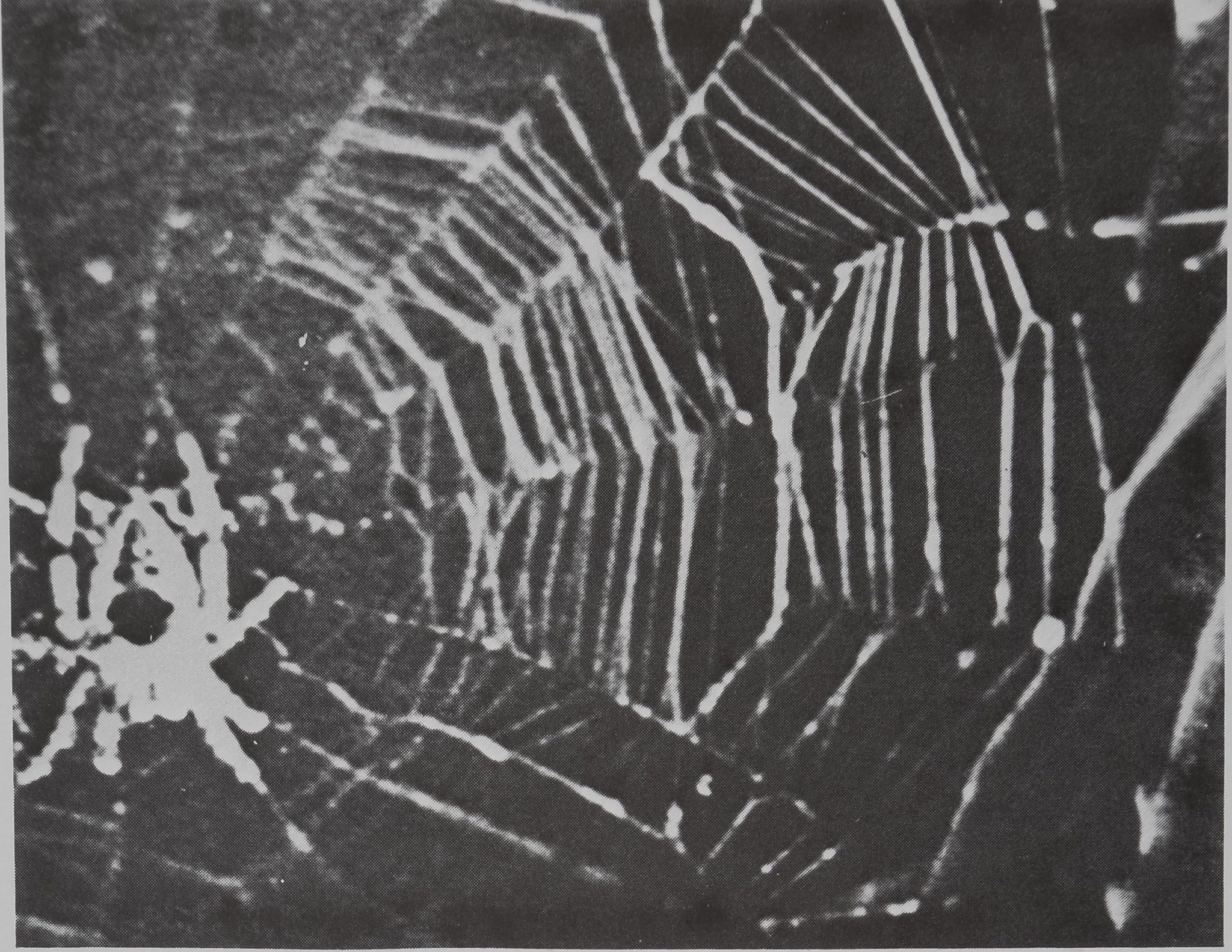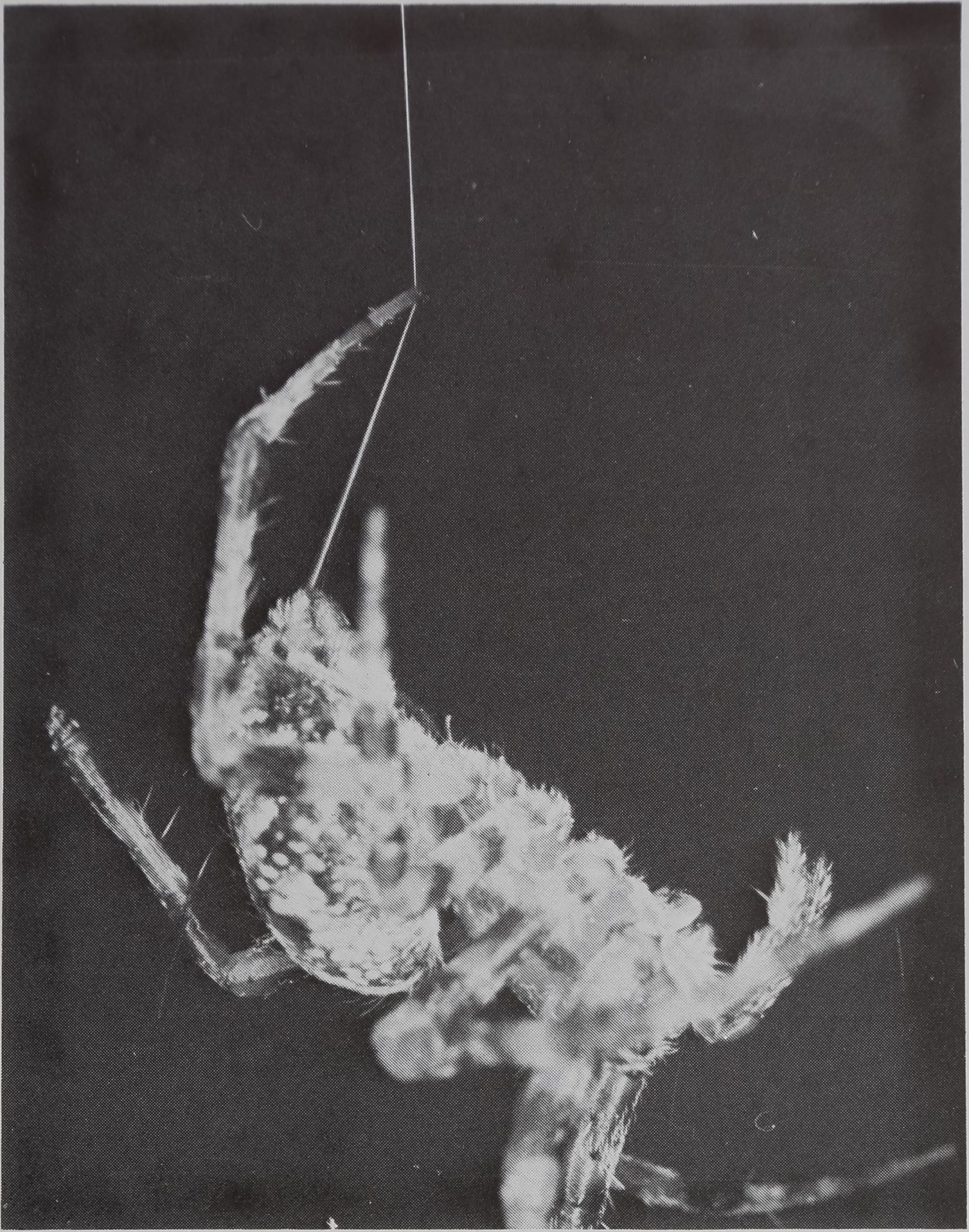Images Collection
View this article in Search Friendly Plain Text
NOTE: This plain text article interpretation has been digitally created by OCR software to estimate the article text, to help both users and search engines find relevant article content. To read the actual article text, view or download the PDF above.
Witt, P. N., et al 1977. Spider web-building in outer space: evaluation of records from the Skylab
spider experiment. J. Arachnol. 4:115-124.
SPIDER WEB-BUILDING IN OUTER SPACE:
EVALUATION OF RECORDS FROM THE SKYLAB SPIDER EXPERIMENT
Peter N. Witt
Mabel B. Scarboro
Rubenia Daniels
N. C. Department of Mental Health
Research Division
Raleigh, North Carolina
David B. Peakall1
Cornel|;|Jniversity
Ithaca,New York
Raymond L. Gause
Marshall Space Flight Center
Huntsville, Alabama
ABSTRACT
Two spiders built orb-webs in Skylab under zero gravity only four days after release from transpor-
tation vials. The first webs resembled pre-flight controls in size and regularity, but the unusual
distribution of radial angles and thinness of thread together with a probably low number of turning
points in the spiral indicated a deviation from e®|th webs which can be attributed to the absence of
gravity as a cue. Other web changes like a gradual decrease in regularity, diminished web size, and the
spiders’ decrease in body weight are identified as being likely consequences of starvation, Skylab stress
and unknown circumstances not directly connected with zero gravity.
INTRODUCTION
Evaluation of measurements taken from the photographs of a spider web provides
detailed information on the animal’s behavior during web construction for a period of
about 30 minutes. Extraordinary circumstances like changes in the environment influence
behavior and are reflected in web measurements (Witt, et al., 1968). The photographic
record shows that web parameters are sufficiently constant to make measurements pre-
dictable for an individual, and it contains enough detail to show the consequences of
environmental stress on the builder. Such considerations prompted one of the authors
(P.N.W.) to respond to an invitation from the National Aeronautics and Space Adminis-
tration in 1968 to propose a project for the Biosatellite Program entitled “Effects of
weightlessness on web-building behavior of spiders.” It was suggested that spiders be sent
into space, and that after their return to earth their web-building capability would be
Current Address: Canadian Wildlife Service, Ottawa, Canada K1A OH 3
116
THE JOURNAL OF ARACHNOLOGY
carefully compared to pre-flight webs. In a second experiment actual photography of
webs built in a space-laboratory would be performed, and the photographs evaluated in
comparison with earth webs. The Biosatellite Program was not flown.
Conditions beyond these laboratories’ control led to the adoption of a prize-winning
proposal by Judith Miles, a high school student from Lexington, Massachusetts, in 1972
to incorporate a spider web-building project into plans for Skylab II; she had read about
our spider-web measurements in the National Geographic (Zahl, 1971). She submitted a
proposal for an experiment as an entry in the NASA Skylab Student Experiment Compe-
tition. Her proposal was selected by a panel of National Science Teacher Association
judges as one of the experiments which they recommended for NASA for flight in
Skylab. We provided instructions to NASA scientists and J. Miles, but were no longer
directly involved in the planning process.
In May of 1972 we had an opportunity of evaluating web-photographs of two spiders,
which had been subjected at the Marshall Space Flight Center to vibration and “Skylab
atmosphere (70% 02 30% N2)/’ in simulation of non-gravity stress factors during launch.
For spider No. 1 four photographs of webs built directly before the experiment were
compared with the measures of three webs built shortly thereafter; for spider No. 2 three
webs before and six webs after the experiment were measured. We found no consistentH
statistically significant change in 27 web parameters, covering size, shape regularity and
web fine-structure.
When the Apollo spacecraft with three astronauts was launched on 28 July 1973, two
Spiders in small vials together with two flies were carried along. The first spider was
released into a frame which would permit web-building in Skylab on 4 August, the second
Spider was released on 2J.August 1973. At that time we had an opportunity to watch TV
pictures of the two spiders. Finally, in April of 1975 we received a package from NASA
with flight protocols and photographs of spiders, webs and threads. Mainly the evaluation
of the material Ü the package is the subject of the following report.
MATERIALS AND METHODS
Web measurements: A protractor centered on the hub of the web was laid over each
picture; a ruler with a notch at 0 mm could turn around the center of the protractor.
Each point where thread touched thread could thereby be defined in polar coordinates.
The figures for a reduced number of measuring points (about 10% of actual number) were
fed into a computer, which was programmed to print out 27 web measures, defining the
structure’s regularity, shape, size and fine structure. For more information on web mea-
surements see Witt, et al.% 1968. Where only incomplete measures were available, the
evaluation was done without computer, using as many points as could be identified.
There were five pre-flight web photographs available for evaluation, four built by
spider 1, one built by spider 2; all but one picture showed such low contrast that we were
unable to obtain a complete set of web measures. In order to increase the number of
control measurements, we added to the one measurable NASA web photograph five
photographs from webs built by spiders of comparable age, body weight and species in
our laboratory. An overlay of transparencies of one set of photographs onto the pre-flight
webs, and statistical comparison of obtainable measurements, showed no recognizable
differences between the pre-flight controls and our laboratory webs.
There were five in-flight webs photographed, each of which was incompletely recogniz-
able. Only the radial angles and some spiral distances could be measured with some degree
WITT ET AL.-SPIDER WEB-BUILDING IN OUTER SPACE
117
‘taeKwi angles and acme epif al
of accuracy. Angle regularity and distribution of size of neighboring angles as well as
spiral spacing in one or two directions could be used for statistical comparison. In one
web, which does not appear on a photograph, the astronauts reported the number of radii
and spiral turns.
On visual inspection, there was one apparently very regularly spaced web (angle and
spiral turns); this is the second web built in flight by spider 1. The other four show all the
characteristics of an Araneus web, like hub, radii, spiral and frame; but they were of small
size and highly irregular spacing, somewhat comparable to webs built after a medium dose
of d-amphetamine (Witt, 1971).
Web size could not be determined, because scale and periphery of webs were not on
the photographs.
Thread thickness was shown earlier (Christiansen, et al, 1962) to be dependent on the
weight of the builder. A number of close-up photographs (400-2000x) of pieces of thread
were available for both spiders, pre-flight and skylab. Unfortunately it was not possible to
identify the type of threads with any certainty, but the astronauts reported that the web
material they collected was from a regular web. Certainly there is no evidence that
material from the sticky spiral was involved, since no glue droplets could be seen. The
thickness was measured by one of us (D.B.P.) on the photographs.
A special question was whether the absence of gravity would do away with the com-
monly observed difference between angle size North and angle size South. The compari-
son was carried out in graphic and statistical format between the one regular in-flight web
and the clearest pre-flight control.
At the end of August, 1973 the television news showed a short record of movements
of both spiders, after spider 1 had been in the frame for several weeks and spider 2 had
just been released. Through the courtesy of the Durham, North Carolina CBS station we
were able to see the film segment many times and observe the animals’ movements.
Subjective evaluation of these observations was included.
RESULTS
The clearest, and in our opinion most important result is the photographic and
observational evidence that both Araneus diadematus built several orb webs in Skylab,
essentially under weightless conditions. One of these webs, which was built by spider 1
six days after release into the cage and 14 days after launch, looks on first inspection
similar to pre-flight control webs. This indicates that the animals were able to pull threads
out of the spinnerets and space the threads with their legs according to accustomed
patterns of behavior (Figs. 1 and 2). The spiders continued to build a trap for flying prey
under the very strange conditions of Skylab.
Measurements of radial angles reveals that in the one regular web radii were neither
more regularly spaced than in controls nor significantly more irregular. However, Fig. 3
shows that the distribution of angle size is unusual in flight: while on earth most wide
angles are in the top or Northern part of the web and most narrow angles in the lower
part or South, the Skylab web shows about equal distribution in all sections. The range
was between 8° and 25° in the pre-flight web, with a mean angle size of pre-flight control
North 15.58, pre-flight control South 11.53; in-flight the range was between 8° and 23°,
North 15.75, South 14.25. It appears that, lacking the cue from gravity, the web lost its
North-South asymmetry.
118
THE JOURNAL OF ARACHNOLOGY
Fig. 1.—NASA photograph of web built by an adult female Araneus diadematus Cl. spider in the
pre-flight simulation experiment. The picture shows all the characteristics of the adult web of the
species; note particularly the North/South asymmetry in the radial angle size and spiral distances, and
the turning points in the spiral (arrow), which indicate the places where the web-building spider
reversed directions.
Spiral size could not be measured, because the photographs do not show the outer-
most turns. A figure for spiral regularity can be established for pre-flight controls, and
separately for the one regular in-flight web and other in-flight webs. Where there were no
reference scales, the spiders of known size could be used for projecting web photographs
to original size. In five pre-flight webs the spiral regularity was calculated at 0.390 ±
0.093 West and 0.403 ± 0.033 East. This means that distances between spiral turns varied
less than 0.5 mm, indicating relatively regular spacing of consecutive spiral turns. In the
one regular in-flight web the corresponding figures are 0.333 in the West and 0.69 in the
East; there is no significant difference between the two sets of webs (Fig. 2). One of the
irregular in-flight webs (Fig. 4) was measured showing a mean spiral regularity of 0.70
West and 0.96 East, which is significantly different from pre-flight and regular in-flight
below the 5% probability level: this in-flight web had a spiral less regular than controls.
In looking at Fig. 2 another interesting difference appears between the regular in-flight
web and pre-flight controls: while there are no turning points in the piece of spiral in the
figure which was built in-flight, there are several in the pre-flight control (compare also
Fig. 1). This difference is less conspicuous when the whole webs are inspected: in very
few places where photographic contrast permits recognition of sufficient detail, turning
points can be identified in pictures taken in flight. However, it can be stated with some
confidence, but without exact figures to back up such a statement, that the web-building
spider in Skylab turned less frequently than under pre-flight conditions while it construct-
ed the sticky spiral.
WITT ET AL.~SPIDER WEB-BUILDING IN OUTER SPACE
119
Fig. 2.-A low-contrast photograph of the highly regular web built in Skylab was overlaid with
transparent paper and three sections in the East of the web traced with black tape (b); the same
procedure was used for a pre-flight web (a), so that both figures could be compared. Note the absence
of turning points (arrow) in the traced part of the spiral in the in-flight web (however, there were a
few turning points in other parts of the web), the regularity of spiral spacing, and the seventh spiral
turn from the center, which crosses two radii without being attached, something which has been
described in d-amphetamine webs by Jackson (1974).
Fig. 3.-Radial angle size (ordinate) is plotted against number of radius (abscissa) for one pre-flight
(single values: black circles; mean: dashed line) and the regular in-flight web (single values: open
circles; mean: dotted lines). After South had been determined by the spider’s head-down position, left
horizontal is designated as one; right horizontal (rh) (=West) in both webs angle No. 14. Note the
relatively large difference in mean values between North and South in the pre-flight web as compared
to the in-flight web value, likely reflecting the absence of the gravity cue in Skylab.
120
THE JOURNAL OF ARACHNOLOGY
Fig. 4.—This is one of several pictures of part of a highly irregular in-flight web. Similar patterns are
built on earth directly before and after a spider’s molting, by old spiders shortly before death, and
after a high dose of a stimulant drug like dextro-amphetamine. We can not be sure that weightlessness
caused this unusual pattern. Compare to Fig. 2 which indicates that under in-flight circumstances a
regular web could also be constructed.
Unfortunately we were unable to measure shape and size of webs in flight; this would
have required a camera with a wide-angle lense, or more distance between camera and
web than was possible. However, there are close-up photographs of threads spun before
and during flight. Evaluation of diameter suffers from uncertainty about which threads
are photographed. If we assume that we measured on the pictures comparable threads in-
and pre-flight—i.e., radii or draglines—thé Skylab spiders laid some 20% thinner threads
than the same animals on earth. Such a result is particularly interesting when one com-
pares it to thread thickness measurements by Christiansen et al. (1962), performed on
spiders which carried extra weight. Under that condition, which may be considered
opposite to the weightless spiders in Skylab, thread thickness was found increased over
lighter controls.
Screening of the television pictures shed some light on the time course at which the
Skylab spiders adapted to the new and unusual conditions. On 28 August 1973 the CBS
Evening News showed how one of the spiders, apparently the one which had been
released on 4 August, was captured by the astronauts to be returned to its vial, and the
other spider was released into the frame. An observer described this as . . the spider
newly put in tumbled, its movements were head over heels, as never seen before; the
animal rotated in space while moving in one direction, bounced off the frame and moved
back. In contrast, the first spider ran very competently along the strands to escape from
the astronauts.” This observation would tend to confirm conclusions drawn from web
records that there is a transition time during which spiders gradually acquire the skill to
move “competently” under weightless conditions.
WITT ET AL.-SPIDER WEB-BUILDING IN OUTER SPACE
121
DISCUSSION
After it has been established that spiders are able to build orb webs in outer space, the
most interesting question to be answered is whether these webs show changes character-
istic for the special condition, and to interpret such changes. When all possible factors
which could influence web-building are subtracted, can we find something which informs
about the special way in which highly patterned behavior adapts to conditions which
cannot have occurred before in the entire evolutionary history of the orb-web building
spiders. One difficulty is the small sample size which prohibits statistical comparison. But
a number of questions can be answered, from careful analysis of even an incomplete
photograph of a web built in outer space.
Earlier experiments, particularly with high doses of drugs which cause paralysis or
convulsions (Witt, 1971), have shown that web-building is a high priority activity of
spiders; no food without webs and no webs without food (Peakall, 1968) and conse-
quently no survival for the individual. The high priority of web-building apparently drove
our animals to try repeatedly without success, until three days after opening of the
transport vial the first animal was reported to build a web in August. There exist photo-
graphs and a protocol which indicate that the first web was preceded by considerable
thread laying along the confining frame. As far as the photograph permits to see details,
the first web looks like a medium-sized earth web of average regularity. It is not possible
to reconstruct from the protocol whether this first web was destroyed by the astronauts
or eaten by the spider, as is routinely done in our laboratory. We only know that the
highly regular web, part of which is shown in Fig. 2, was built several days later, probably
a week after release. Webs thereafter became irregular (see Fig. 4), and the spider was
dead on return to earth after 59 days. The second spider built at least one large web
which was not photographed, but reported as containing 22 radii and 30 spiral turns. This
corresponds to a large web on earth (see Fig. 1). Later webs were highly irregular, but
with the main characteristics of the orb, i.e. hub, radii, spiral and frame. It appears safe to
conclude from such data that the spider can sufficiently reorient itself at zero gravity, to
construct an orb web, gravity being a less important cue in web-building than had been
assumed. The existence of horizontal orb webs suggests a similar interpretation, because
there exist obviously different adaptations to gravity.
In order to get into Skylab and during their stay, the two animals were subjected to
many stressful conditions which could have influenced web-construction. The pre-flight
simulation experiments indicate that vibration and the special atmosphere had no measur-
able short-term effect on web geometry. Confinement in tubes similar to those used for
transport to Skylab is known to cause relatively small and irregular webs (Reed, et al.,
1970); but it has also been shown that such effects wear off in three days. Only the first
web of spider 1 and the irregularities in spider 2’s web can possibly have been influenced
by consequences of confinement in tubes.
Spiders can survive two to three weeks of food deprivation without apparent damage
to web-building (Witt, 1963); however, they need frequent supply of water. It is known
that one fly was put into each vial on 25 July, and that on 9 and 24 August “fillet” was
put into the spiders’ web; this was “kicked out,” as we might have expected on the basis
of its properties, which are strange to spiders. However, tests made at Marshall Space
Flight Center had indicated that juices were extracted from pieces of rare fillet placed in
the web. After the juices had been removed, the spiders would then eject the shrunken
residue from the web just as they do a fly carcass. Photographic evidence was obtained
THE JOURNAL OF ARACHNOLOGY
which led to the decision to try to feed the space spiders with the astronauts’ meat scraps.
Spider 1 was at least watered once, on 11 August. Spider 1 was found dead on return to
earth, spider 2 died on 16 September in space. The comparison of photographs and
weights pre- and post-flight make it likely, that thirst and starvation at least contributed
to their death. Spider 1 had changed from 180 mg before to 103 mg after the flight,
spider 2 from 210 mg before flight to 50 mg at time of death. There is no indication that
molting, which is always dangerous and which would likely have been very difficult in
zero gravity, contributed to the spiders’ death. Taking all data into consideration it is
concluded that there were two quite healthy spiders in Skylab in the first two weeks,
which afterwards changed into slowly dying animals. The decline in vigor could well
explain increasing irregularity and decreasing size of webs. But the existing data do not
permit us to say whether the animals’ decline was due to specific Skylab stress conditions,
starvation, or other circumstances. The time was too short and the animals too young to
consider high age as a contributing factor.
Evaluation of web-patterns should shed some light on a problem which has puzzled
investigators for some time (Mayer, 1953), and which had been given as one reason for
taking web-building spiders into Skylab because it could not be solved on earth: is the
North/South asymmetry of the orb-web dependent on the spiders’ perception of gravity?
One possibility could well be imagined, namely that a young spider is guided by gravity to
produce shorter radii and wider radial angles on top of the web, and longer radii more
narrowly spaced on the bottom. Older spiders had become so accustomed to the asym-
metry, that they would retain the pattern without the cue. Our analysis (Fig. 3) indicates
that even an adult animal which has presumably constructed about 100 asymmetric orbs
in its life-time, shows a lack of North/South asymmetry in Skylab; this is independent of
where we assume North to be. Decrease of pendulum turns, which help to fill a long
frame with as much round spiral as possible, is another indication of pattern change in
zero gravity. Another characteristic of many earth webs, namely an asymmetry of the
position of the hub toward the corner of the frame, can be recognized in some of the
space photographs. Mayer (1953) found an asymmetric (East/West) hub and a round
spiral in a web built on a slowly rotating Klinostat. This appears not surprising for
in-flight construction if the difficult circumstances are considered under which a thread is
spun in zero gravity: the spider prefers the web close to the corner of the cage where it
can stretch relatively short frame threads. The conclusion is that each web, including
those built in outer space, reflects in its pattern also cues from the environment which
were present during its particular construction.
Experiments conducted earlier had led to the tentative conclusion, that spiders can
adapt thread thickness to body weight (Christiansen, et al., 1962). It has been hypothe-
sized that a heavier animal would require a thicker thread to hold it suspended. Compari-
son of web weights and thread lengths (length over weight used as an index of thickness)
in animals before and after a lead weight has been fastened to the dorsum of the céphalo-
thorax supported the hypothesis. The Skylab pictures which indicate that weightless
spiders built most likely 20% thinner threads than the same animals pre-flight, point to
the same mechanism. Some control mechanism which regulates silk thickness at the
spinnerets of the weightless spider had possibly received signals through the central ner-
vous system from the gravity perceptors that thinner silk would suffice. However, so little
of the organs and the pathways possibly involved are known, that this remains merely a
working hypothesis.
WITT ET AL.-SPIDER WEB-BUILDING IN OUTER SPACE
123
Fig. 5.-A female Araneus diadematus spider was photographed while it descended on its thread.
Note the emergence of silk from the spinneret at the end of the spider’s abdomen, and the position of
one of the hind legs on the thread. However, spiders can also descend on a new silk strand without the
help of a leg, using some mechanism along the path of the emerging thread to regulate speed; the
animal’s weight provides the pull.
Something that has been observed by nearly everybody in spiders is their ability to let
out thread as they descend (Fig. 5), and that they can climb back up on sudi a thread,
taking the silk in during the return. This observation, taken together with the fact that
spiders always run on the underside of a web or a bridge thread, hanging down as they
move, makes one aware of the important role which the use of the animal’s own weight
plays in locomotion and silk production. It is probably the absence of body weight which
disturbed each of the two animals severely during the first days after release from the vial.
They had to build frame threads by running along the given structures rather than
dropping down; reports about their restless behavior preceding construction of the first
web in Skylab can be interpreted as exploring such alternate mechanisms. Once the
spiders had accomplished this, they showed no more difficulty in laying radii and spiral
turns, with the result of accomplishing a large, regular web. Thus those features which
underly detailed symmetry and make the orb an orb do not require gravity as a cue. The
ability of an invertebrate animal with as rigid a behavior pattern as orb-web construction
which is relatively independent of experience (Reed, et al> 1970) to find alternate ways
124
THE JOURNAL OF ARACHNOLOGY
to complete a perfect trap for food and thereby increase its chance for survival, is
possibly the most interesting finding in the evaluation of Skylab web records.
SUMMARY
Two spiders built orb-webs in Skylab under zero gravity only four days after release
from transportation vials. The first webs resembled pre-flight controls in size and regu-
larity, but the unusual distribution of radial angles and thinness of thread together with a
probably low number of turning points in the spiral indicated a deviation from earth webs
which can be attributed to the absence of gravity as a cue. Other web changes like a
gradual decrease in regularity, diminished web size, and the spiders’ decrease in body
weight are identified as being likely consequences of starvation, Skylab stress and
unknown circumstances not directly connected with zero gravity.
ACKNOWLEDGEMENTS
All records came from the NASA Marshall Space Flight Center. We acknowledge the
help from Mr. Henry Floyd, manager of the Skylab Student Project, who provided the
photographs and other data as the basis for our evaluation. Mr. Wolfgang Brandner from
Marshall Space Flight Center participated in the early stages of experimentation and
contributed substantially to the preparation of the Skylab Spider Experiment.
The web measuring work was carried out in the laboratories of the North Carolina
Department of Mental Health, Research Section, and was supported by National Science
Foundation Grant Number GB 25274 to Peter N. Witt. Thread measurements were per-
formed at Cornell University.
LITERATURE CITED
Christiansen, A., R. Baum and P. N. Witt. 1962. Changes in spider webs brought about by mescaline,
psilocybin and an increase in body weight. J. Pharmacol, exp. Ther. 136:31-37.
Jackson, R. R. 1974. Effects of d-amphetamine sulfate and diazepam on thread connection fine
structure in a spider’s web. J. Arachnol. 2:37-41.
Mayer, G. 1953. Untersuchungen über Herstellung und Struktur des Radnetzes von Aranea diadema
und Zilla-x-notata mit besonderer Berücksichtigung des Unterschieds von Jugend^ and Alters-
netzen. Z. Tierpsychol. 9:337-362.
Peakall, D. B. 1968. The spider’s dilemma. New Sci., Jan. 4:28/29.
Reed, C. F., P. N. Witt, M. B. Scarboro and D. B. Peakall. 1970. Experience and the orb web.
Developm. Psychobiol. 3:251-265.
Witt, P. N. 1963. Environment in relation to the behavior of spiders. Arch, environm. Hlth. 7:4-12.
Witt, P. N. 1971. Drugs alter web-building of spiders. Behav. Sci. 16:98-113.
Witt, P. N., C. F. Reed and D. B. Peakall. 1968. A spider’s web. Springer Verlag, Berlin.
Zahl, P. A. 1971. What’s so special about spiders. Nat. Geogr. 140:190-219.
